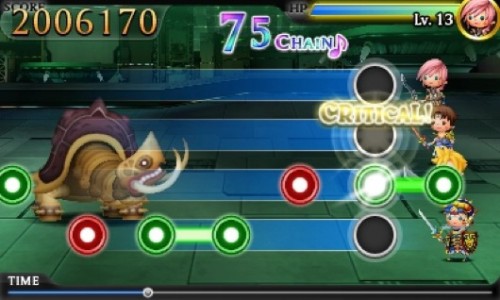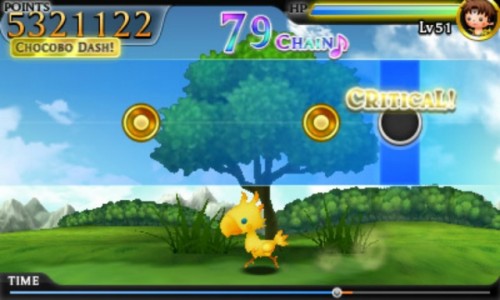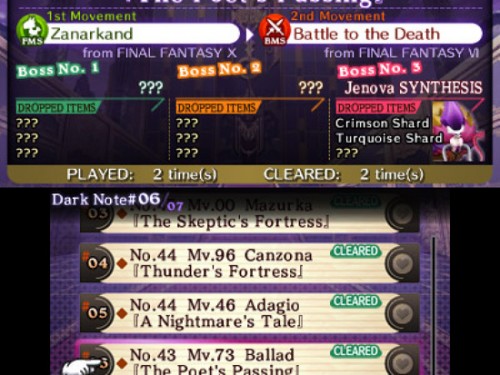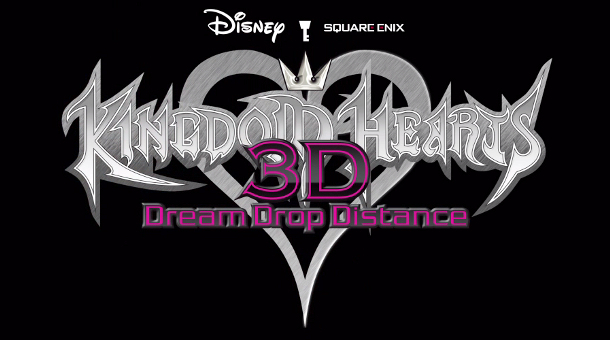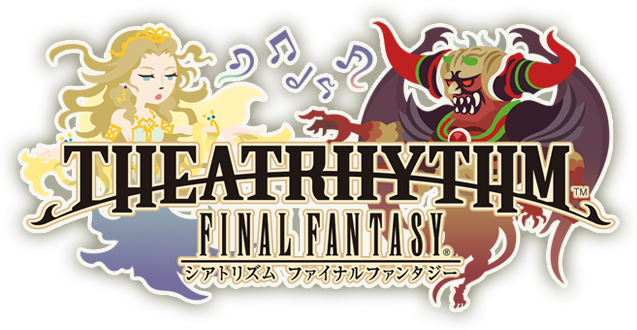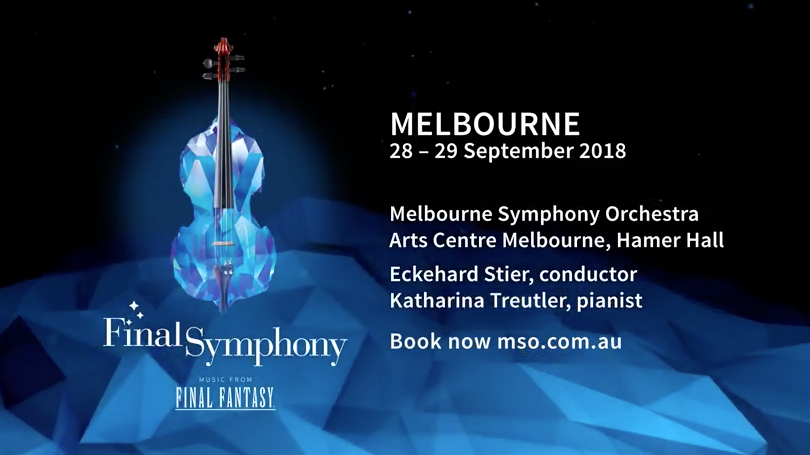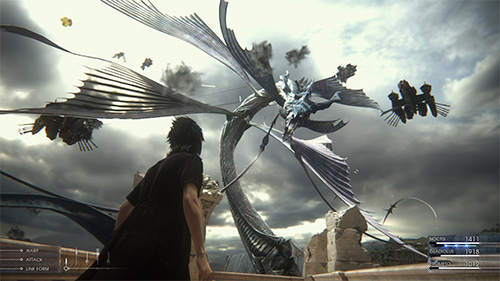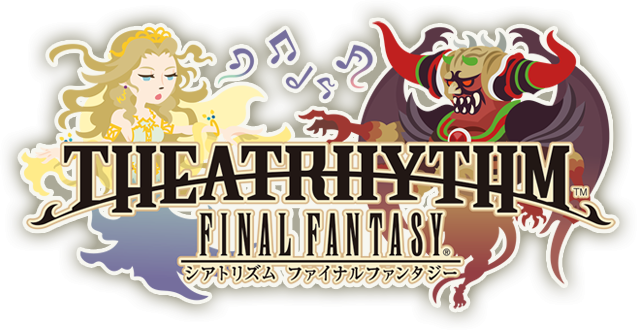
Theatrhythm Final Fantasy is a little different to your typical Final Fantasy spin-off. It’s the first rhythm game in the series, and with a little over 70 songs from the 13 main series games, there’s a strong selection of music from a series which has long been known for featuring great soundtracks. All but a few of the tracks in Theatrhythm were originally composed by the excellent Nobuo Uematsu, who has been the main composer for the series since the very first game, back in 1987.
Theatrhythm’s story is quite basic, but is similar to that of the Dissidia: Final Fantasy fighting games for PSP, featuring the gods Cosmos (upholder of peace) and Chaos (incarnation of evil) at war. The heroes from the various Final Fantasy games are called together by Cosmos, and fight to defeat Chaos’ forces. Chaos’ force is made up of enemies and villains from all of the previously released main series Final Fantasy games, including Adamantoises from Final Fantasy XIII, Jenova from Final Fantasy VII, Ultros from Final Fantasy VI, Flan monsters, and many more. Along with the familiar tunes, there’s also some very familiar faces to accompany them. Each Final Fantasy game has one representative character within Theatrhythm, and they can be recruited for your party. This means that there’s 13 different party members to choose from, out of the box, but that number can double if you put in the amount of time required to unlock each game’s second character (and third character, in the case of Final Fantasy VII). It’s a shame that the series’ direct sequels (Final Fantasy X-2 and Final Fantasy XIII-2) didn’t receive any representation in the game though. There’s no shortage of fans for both titles, and they were commercially successful, so the fact that they’ve effectively been ignored seems a little odd.
As a rhythm title, it’s fairly easy to imagine what the game would be like, but Theatrhythm manages to take the genre in an interesting direction. While it’s primarily a rhythm game, Theatrhythm could also be called a hybrid of two genres, rhythm and JRPG. Due to its significant use of experience points, levelling up, and an item/loot system, the game adds a surprising amount of depth to what might have been a fairly vanilla experience. After starting a new game, and playing through a brief, but thorough tutorial, you’ll be asked to create a party of four characters. Each character has their stats and abilities, which can be viewed at any time. Completing a song will earn you experience points, which will make your characters level up over time and improve their stats. Character stats have various effects on the gameplay, such as determining how much damage you deal to enemies, and how many times you can afford to make mistakes without failing a stage. Characters learn new abilities as they level up, and these can either boost their stats, or offer other useful effects during stages. Theatrhythm features three main modes, Series, Challenge, and Chaos Shrine.
The Series mode contains a large portion of the game’s content, and allows players to select a Final Fantasy game of their choice. Each game has a set playlist of 5 different pieces of music, which are played through in order, starting with the game’s opening theme. Each piece of music is tied to a particular type of stage, from a pool of three featured types: BMS (Battle Music Stage), FMS (Field Music Stage), and EMS (Event Music Stage). Each one plays a little differently, with some being easier than others.
The FMS segments feature just one line of notes that scroll across the screen, but you’re often required to slide the stylus up and down on the touch screen as your party leader walks across the overworld of your selected Final Fantasy game. The notes scrolling across the screen maintain a set speed over the course of the song, never speeding up or slowing down, which makes things easier. Songs which have FMS stages are always from the game’s overworld, such as Sunleth Waterscape from Final Fantasy XIII. While playing an FMS stage, you’ll also be given the opportunity to summon a Chocobo, marked by the appearance of specially coloured notes on-screen. Successfully hitting the majority these notes will cause a Chocobo to appear (as you can see in the screenshot below), and you’ll be able to score bonus points for a short period of time.
BMS stages feature a side view of your party in battle formation, with a setup similar to the older Final Fantasy games as you tackle classic enemies. In order to fight, players need to tap and swipe the touch screen in time with the music, as coloured notes slide quickly across the screen from right to left. There are four lines of notes, one for each party member, and hitting a note successfully will cause the corresponding character to attack. The better your timing, the more damage your characters will deal to enemies. The goal of these stages is to defeat as many enemies as possible before the music finishes, as you’ll earn items for doing so. BMS stages tend to have the fastest moving notes, as well as the most complex combinations of taps, holds and directional swipes, which generally makes them the hardest stages that Theatrhythm has to offer. Songs which have BMS stages are Final Fantasy battle themes, such as the much loved One-Winged Angel from Final Fantasy VII.
EMS stages are a little different to the other two. Instead of seeing your party members on-screen, the notes are displayed on top of a video which plays over the course of the song. The video is composed of bits and pieces of the event scenes from your chosen game. For example, Final Fantasy X‘s stage features clips of Tidus and Yuna’s romantic scene in the Macalania Forest, Yuna’s marriage to Seymour, as well as her performance of the Sending. Instead of moving across the screen from right to left, notes appear all over the screen, and follow a set path which snakes around. The appearance of notes follows the tempo of the song, suddenly speeding up or slowing down at times, which gives these stages their own element of challenge.
All three types of stages are a blast to play, and offer a slightly different type of challenge. They never feel unfairly difficult, and the movement and timing of the on-screen notes follow the beat of the music perfectly. It’s a great experience, and at times it really feels as though you’re a part of the music, tapping notes to make the tune play. No matter what type of stage you’re playing, items can be used in order to help yourself. These range from classic items like Potions and Phoenix Downs (which allow your party to recover when you make mistakes during a stage), to items which allow you to choose which summon you activate during BMS stages. Items are consumed when used though, and are in very limited supply, so they must be used wisely.
Challenge mode is exactly what it sounds like, a place for you to practice songs, where you also have control over the difficulty. While Series mode stages are locked to the easiest difficulty, in Challenge mode you can turn them up to Expert or the even harder Ultimate difficulty, which increases the speed of the notes scrolling across the screen greatly, as well as the number and complexity of the required inputs. Simple enough. The Chaos Shrine, however, is much more interesting. This mode features a series of Dark Notes for you to attempt, which start off at a fairly easy level, but eventually begin to rival the Ultimate difficulty songs. Each Dark Note is composed of two random songs (one FMS and one BMS), which must be played back-to-back. Gameplay is the same as in the Series mode, but the difficulty increases with each successive note (a harder one is unlocked every time you clear one). However, this increased difficulty offers a reward: rare items, and more importantly, shards. Shards are gems of various different colours, which are obtained by defeating random bosses which lurk within each Dark Note’s BMS. Collecting eight of a particlar shard colour will unlock a new playable character for you to recruit for your party. So, instead of simply challenging yourself with the Dark Notes, you’ve also got a goal to work towards.
Graphically, the game fares very well. It’s rendered entirely in 2D, but it’s a design choice that works well here. The minimalistic, yet well designed character and environmental artwork is suitably easy on the eyes, and won’t distract you too much as you try to focus intently on the notes that are scrolling across the screen. Theatrhythm has a bright, largely colourful aesthetic, with plenty of high quality artwork on display. Some may take issue with the minor character re-designs though, as the familiar characters from each game have been shrunk down a bit, and given simplistic faces. It’s a slightly unusual move, but it does reflect the game’s light hearted nature to a degree. The game’s music, as you’d expect from the Final Fantasy series, is excellent. Many fan-favourite songs are featured, and they all sound great, even more so if you plug some headphones into your 3DS. It’s hard to think of tunes that would be more enjoyable to play along to in a rhythm game, and if you’re familiar with the series, you may even find that they bring back some good memories of playing through the games.
Overall, Theatrhythm will be highly enjoyable to fans of rhythm games, especially if they’re also fans of the Final Fantasy series, and a good experience for anyone with an interest in the genre. Newcomers are reasonably well-catered for, with the default difficulty being fairly gentle, but some of the Dark Note content may prove to be slightly tough. Players can practice and replay songs to their heart’s content though, and items can be a big help for getting through some of the especially challenging parts. Practice makes perfect, and if the premise appeals, then there’s few excuses not to pick up a copy of the game. It’s a memorable experience, one of the best available on the 3DS right now.
Enjoyable rhythm gameplay | RPG elements work well | Great soundtrack
Could use a few more songs | No representation for direct sequels

